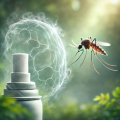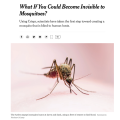Among the most devastating infectious diseases worldwide are insect-borne diseases that are spread by mosquitoes. One such mosquito vector, Aedes aegypti, is of particular concern because it spreads the viruses that cause diseases such as dengue and Zika, which affect millions of people each year. To home in on people for blood meals, female mosquitoes use multisensory integration. They sense the CO2 from our breath, which then causes them to pay attention to other host cues, such as human odors and the images of humans.







